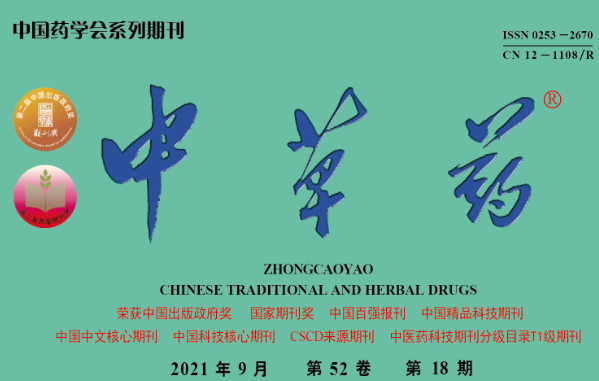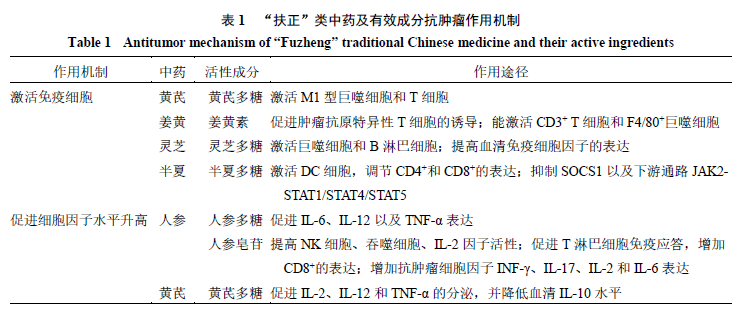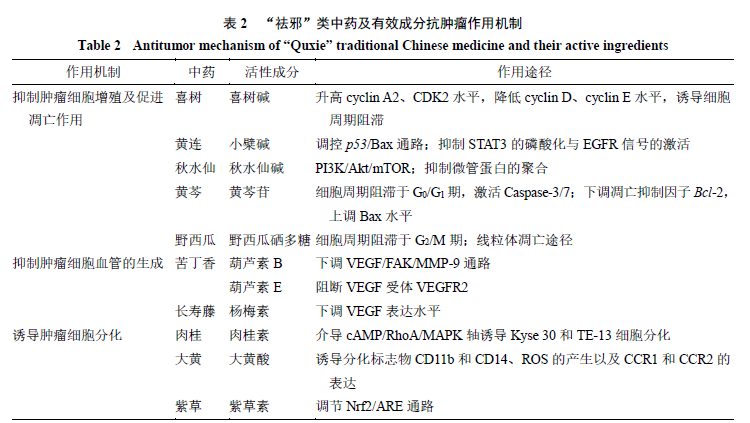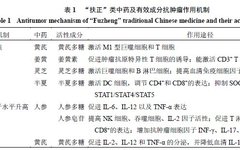

Abstract: This article discusses the relationship between the principles of “Supporting the Right” (扶正) and “Expelling the Evil” (祛邪) in Traditional Chinese Medicine (TCM) and their antitumor effects based on their main active components and mechanisms. “Supporting the Right” enhances the body’s vital energy, preventing external evils from invading and improving overall immunity. “Expelling the Evil” eliminates pathogenic factors that invade the body, such as inducing apoptosis in tumor cells, inhibiting tumor cell proliferation, suppressing angiogenesis, and promoting tumor cell differentiation. In-depth research on the antitumor mechanisms of TCM components provides a basis for the flexible application of the “Supporting the Right and Expelling the Evil” principle in clinical practice, offering new ideas for TCM treatment of tumors and the development of new TCM drugs.
According to the latest global cancer burden data released by the International Agency for Research on Cancer of the World Health Organization in 2020, China ranks first in both the number of new cancer cases and cancer deaths worldwide.[1] Cancer poses a serious threat to the health of Chinese residents, and the situation is very severe. TCM has a history of thousands of years and is rich in resources. TCM has advantages such as multi-targeting, multiple pathways, and low toxicity. Combining the mechanisms clarified by modern science with the effective traditional TCM principles is an essential path for TCM to enter the global stage.
TCM believes that where evil gathers, the vital energy must be deficient.[2] Tumors are a local manifestation of a systemic disease, and their etiology can be summarized into internal and external factors. When the vital energy is weak, the ability to resist external carcinogenic factors is insufficient, making it easy for evil energy to invade the body, disrupting the stability and balance of the organism, leading to tumor formation and malignant biological behaviors such as infiltration and metastasis. The “Essentials of Medical Classics” states that “the accumulation is due to insufficient vital energy and the evil energy’s subsequent invasion,” indicating that the basic pathogenesis of malignant tumors is a continuous struggle between “vital deficiency” and “toxic evil”.[3] Zhang Jing et al.[4] believe from a TCM perspective that the accumulation of toxic evil in the body is fundamental to tumors, and that attacking the evil is the primary treatment to eliminate cancer toxins. Niu Xuejiao et al.[5] advocate for supporting the right and solidifying the foundation as the fundamental method for treating tumors, believing that self-formulated supportive formulas can effectively inhibit the proliferation of colon cancer LOVO cells. Other TCM scholars believe that antitumor treatment should balance both “Supporting the Right” and “Expelling the Evil” to better stabilize the internal environment of the body. Liu Sutong et al.[6] found that the supportive and expelling method can improve the progression-free survival of lung cancer patients. Fang Zhihong et al.[7] proposed through the study of the mechanisms of supportive and expelling formulas that they can induce apoptosis in lung cancer A549 cells. Therefore, the rational application of the “Supporting the Right and Expelling the Evil” principle will rely on in-depth research into the antitumor mechanisms of TCM. This article explores the relationship between TCM’s “Supporting the Right” and “Expelling the Evil” and their antitumor mechanisms based on the main active components of TCM, aiming to provide a theoretical basis for clinical TCM antitumor treatment.
1 “Supporting the Right” Antitumor Mechanisms of TCM
According to the “Essentials of Tumor Diagnosis and Treatment,” “Traditional Chinese Medicine believes that the formation of tumors is due to the deficiency of vital energy, dysfunction of the organs leading to stagnation of qi and blood, accumulation of phlegm and toxins, and heat toxins leading to the formation of masses.” Treatment should start from the source, supporting the right and cultivating the foundation; only when the body’s vital energy is abundant can it enhance the ability to resist external evils and regulate the body’s imbalanced internal environment.
1.1 Activation of Immune Cells
Immune cells are important cells in the body that perform immune surveillance, mainly including T lymphocytes, B lymphocytes, macrophages, natural killer cells, and dendritic cells (DC).[8]
Huang Qi (Astragalus membranaceus) is a dried root of the leguminous plant Mongolian Astragalus, known as the “King of Qi Tonics.” Astragalus polysaccharides can improve immune suppression by activating M1 macrophages and T cells in the tumor microenvironment.[9] In addition, Astragalus polysaccharides can promote the secretion of interleukin (IL)-2, IL-12, and tumor necrosis factor-alpha (TNF-α), while reducing serum IL-10 levels, indicating that Astragalus polysaccharides exert antitumor effects by enhancing immune function.[10]
Turmeric (Curcuma longa), commonly known as “Indian Gold,” is both a medicinal material and a spice, with curry powder made from turmeric and other spices. Turmeric extract curcumin can regulate the activation of various immune cells and the expression of inflammatory factors, making it a potential immune modulator. Hayakawa et al.[11] demonstrated that curcumin restores targeted activation signaling in cancer cells and immune cells, enhancing the induction of tumor antigen-specific T cells. Kuo et al.[12] proved in vitro that curcumin combined with resveratrol can activate CD3+T cells and F4/80+ macrophages, inhibiting the growth of colon cancer CT26 cells.
Lingzhi (Ganoderma lucidum) belongs to the Ganoderma family and has antitumor, antimicrobial, antiviral, and anti-aging effects. Triterpenoids are typical chemical components of Lingzhi with significant anticancer effects. Zhang et al.[13] found that Lingzhi extract polysaccharides have antitumor activity, with a significant activation of bone marrow macrophages and splenic B lymphocytes observed in tumor mice after treatment, accompanied by a large production of immunoglobulins. Lingzhi polysaccharides can also regulate the expression levels of serum immune cell factors, enhancing antitumor immune stimulation activity.[14]
Banzhu (Pinellia ternata) is a plant in the Araceae family, containing various antitumor components such as Pinellia protein, Pinellia polysaccharides, and Pinellia alkaloids.[15] Wang et al.[16] demonstrated that Pinellia polysaccharides inhibit the growth of cervical cancer by activating DC cells, thereby regulating the expression of CD4+ and CD8+ cells. The effect of Pinellia polysaccharides on DC cells is achieved by inhibiting suppressor of cytokine signaling 1 (SOCS1) and downstream pathways such as Janus kinases 2 (JAK2)-STAT1/STAT4/STAT5.
1.2 Promotion of Cytokine Levels
Cytokines are soluble proteins that mediate communication between cells. Clinical studies have found that pro-inflammatory cytokines have significant antitumor activity, especially IL-2, IL-7, and IL-15, which have been used in vitro to enhance T cell activity.[17] Such studies open a new avenue for the clinical application of cytokines.
Ginseng polysaccharides are bioactive substances found in Panax ginseng, a type of glucan mainly composed of pectin and neutral sugars from ginseng, with the primary active component being ginseng pectin. Lee et al.[18] stimulated mouse peritoneal macrophages with ginseng polysaccharides, and the results showed enhanced expression levels of IL-6, IL-12, and TNF-α, indicating that ginseng polysaccharides have strong immune-enhancing activity, preventing cancer progression and metastasis by activating natural killer cells and other immune-related cells. Other studies have shown that ginseng polysaccharides can act on myeloid-derived suppressor cells (MDSCs), immune factors, and T cells, thereby enhancing the immune function of patients with non-small cell lung cancer and reducing adverse reactions caused by chemotherapy.[19]
In China, Dr. Lu Qi and Dr. Fu Li have improved the preparation process of ginsenoside Rg3, achieving a quality fraction of 95% for the extraction of ginsenoside Rg3, and developed a new anticancer drug, Shenyi capsule.[20] Research shows that ginsenoside Rg3 significantly enhances NK cells, phagocytes, and IL-2 factors, indicating its potential as a highly effective immune promoter. Clinical trials have shown that Shenyi capsules can promote T lymphocyte proliferation, improve the chemotherapy effect in patients with non-small cell lung cancer, and significantly alleviate clinical symptoms of qi deficiency after chemotherapy.[21] Wei Junxian et al.[22] developed a new liposomal system for ginsenoside Rg3, which activates the immune microenvironment, promotes T cell immune responses, and significantly prolongs the survival of tumor-bearing mice and rats with increased CD8+ cells, indicating that ginsenoside Rg3 is a good drug delivery liposome that has a synergistic effect with anticancer drugs. Zhu et al.[23] found that ginsenoside promoted the therapeutic effect of cyclophosphamide on mice, characterized by increased levels of interferon-γ (INF-γ), IL-17, IL-2, and IL-6, thereby enhancing the antitumor immune response in mice.
The method of supporting the right and cultivating the foundation can enhance the body’s immunity, prevent the infiltration and metastasis of cancer cells, and improve the quality of life. Various TCM herbs such as ginseng and Huang Qi can exert their effects by activating immune cell activity and promoting cytokine levels, thus compensating for the deficiency of vital energy and inhibiting tumor growth, as shown in Table 1.

2 “Expelling the Evil” Antitumor Mechanisms of TCM
“Expelling the Evil” TCM includes drugs that clear heat and detoxify, warm yang and disperse masses, transform phlegm, resolve stasis, and attack toxins. These drugs often contain effective components that inhibit tumor cell metabolism, synthesis, and division, directly killing tumor cells and inhibiting cancer progression.
2.1 Inhibition of Tumor Cell Proliferation and Promotion of Apoptosis
Camptotheca acuminata, a plant in the family Nyssaceae, is commonly used clinically to treat gastric cancer, intestinal cancer, liver cancer, breast cancer, and acute leukemia. The Jiangxi “Chinese Herbal Medicine” records that Camptotheca has effects on cancer and dissipating masses, showing good therapeutic effects for those with internal heat toxins and blood stasis. Numerous in vivo and in vitro experiments have shown that the extract of this plant, camptothecin, has strong antitumor activity. Liu et al.[24] demonstrated that camptothecin acts on non-small cell lung cancer, increasing levels of cyclin A2 and cyclin-dependent kinase 2 (CDK2), while decreasing levels of cyclin D and cyclin E, inducing cell cycle arrest.
Huang Lian (Coptis chinensis), Huang Qin (Scutellaria baicalensis), and other related herbs are listed as superior medicines in the “Compendium of Materia Medica.” The “Secret Essentials of External Medicine” states that Huang Lian, Huang Qin, Huang Bai, and Zhi Zi can effectively combat tumors when decocted in water. Yu et al.[25] confirmed through animal experiments that Huang Lian extract berberine significantly reduces the growth of human gastric cancer MKN-45 cells in mice by acting through the tumor suppressor gene p53/Bax pathway. Wang et al.[26] indicated that berberine can hinder the division and growth of gastric cancer cell lines primarily by inhibiting the phosphorylation of STAT3 and the activation of epidermal growth factor receptor (EGFR) signaling, thereby inducing spontaneous apoptosis.
Plants in the Tulipa and Colchicum genera contain a large amount of colchicine, which has excellent anti-inflammatory, analgesic, and anti-tumor effects, and is an ancient anti-inflammatory drug, clinically effective for treating gout.[27] Zhang et al.[28] found that colchicine inhibits the phosphorylation of phosphatidylinositol 3-kinase (PI3K), protein kinase B (PKB/Akt), and mammalian target of rapamycin (mTOR) in human gastric cancer NCI-N87 cells, while the expression of PI3K, Akt, and mTOR remains unaffected. These results suggest that colchicine may induce apoptosis in NCI-N87 cells by inhibiting the PI3K/Akt/mTOR signaling pathway. Guan Fang et al.[29] found that colchicine binding to β-tubulin causes the original straight conformation to bend, creating spatial hindrance with α-tubulin, inhibiting the polymerization of tubulin, preventing tumor cells from undergoing mitosis. However, colchicine has significant toxicity, requiring dosage restrictions, which limits its clinical application.
Huang Qin (Scutellaria baicalensis) can be used to treat inflammation, infections, and tumors. The flavonoid component baicalin in Huang Qin is its main antitumor active ingredient. Baicalin inhibits cell proliferation, arresting the cell cycle at G0/G1 phase, and induces cell death through the activation of the Caspase-3/7 signaling pathway, playing a role in the treatment of leukemia.[30] Wang et al.[31] found that baicalin can activate Caspase-9, 8, and 3, significantly reducing the expression levels of B-cell lymphoma-2 (Bcl-2), thereby significantly inhibiting the metastasis and growth of human breast cancer MDA-MB-231 cells.
TCM believes that the accumulation of evil energy can lead to qi stagnation, phlegm condensation, and blood stasis, resulting in tumors. Therefore, expelling pathogenic evil plays an important role in tumor treatment. The Fudan University Affiliated Tumor Hospital clinically applied Qingyi Huaji Decoction (containing 30g of half-branch lotus, 30g of white flower snake tongue grass, 15g of snake six grains, 10g of prince ginseng, 10g of white atractylodes, 10g of coix seed, 30g of jiaogulan, and 5g of white cardamom) to treat pancreatic cancer, increasing the dosage of half-branch lotus to 90g, resulting in patient improvement. The patient’s tumor marker carbohydrate antigen 199 (CA199) was 357 U/mL at the initial diagnosis, and by June 2013, it was rechecked at 121 U/mL, with imaging examinations indicating stable disease.[32] The “Compendium of Materia Medica Supplement” records that half-branch lotus is cold in nature and can dissipate abscesses, treating dampness and edema, with its diterpenoid components being the main active ingredients that kill tumor cells. Clinically, it has shown excellent effects when combined with Western medicine for treating intestinal cancer, liver cancer, and uterine cancer. Therefore, traditional Chinese medicine and its formulas can eliminate pathogenic evils and achieve antitumor effects.
2.2 Inhibition of Tumor Cell Angiogenesis
Clinically, injections made from combinations of Danshen (Salvia miltiorrhiza), E Zhu (Curcuma zedoaria), coix seed, and Huang Qi can inhibit the formation of vascular endothelial growth factor (VEGF), thereby reducing tumor angiogenesis.[33] Peng et al.[34] reported that Jianpi Jiedu Decoction inhibits the mTOR/hypoxia-inducible factor-1 (HIF-1)/VEGF signaling pathway, downregulating the expression levels of vascular markers CD34 and VEGF, effectively inhibiting the migration, invasion, and angiogenesis of human liver cancer HCT116 cells.
Mirabilis jalapa, also known as sweet melon stem, is a fruit stem of the family Nyctaginaceae, effective for various hepatitis and liver cancer treatments. Triterpenoids extracted from Mirabilis jalapa can promote the self-repair of damaged liver cells and restore liver function. Sinha et al.[35] found that mirabilis B can reduce CD31 expression by downregulating the VEGF/focal adhesion kinase (FAK)/matrix metalloproteinase (MMP-9) signaling pathway, inhibiting tumor cell proliferation and metastasis. Research has shown that mirabilis E can block VEGF receptors in endothelial cells and inhibit downstream protein kinases, indicating potential applications in treating angiogenesis-related diseases.[36]
Known as the “King of Flavonoids,” Ampelopsis grossedentata contains abundant flavonoids. The flavonoid component myricetin has been proven to have significant anticancer activity. Zhou et al.[37] demonstrated that myricetin can inhibit the migration of human umbilical vein endothelial cells, affecting microvascular development and vascular network formation. Additionally, enzyme-linked immunosorbent assay results indicate that myricetin can lower VEGF levels both in vivo and in vitro. Therefore, myricetin can serve as a chemopreventive agent against tumor angiogenesis.
The development of any malignant tumor is a lengthy process, and angiogenesis plays a crucial role in the invasion, metastasis, and proliferation of tumor cells. Without a substantial blood supply, tumors remain in a microstate and are unlikely to worsen. Therefore, inhibiting angiogenesis is an important target in antitumor research.
2.3 Induction of Tumor Cell Differentiation
The occurrence of tumor cells is primarily due to the disruption of the balance between differentiation and proliferation, leading to the gradual differentiation of cells into mature tumor cells. Currently, inducing differentiation is a new method for tumor treatment. Traditional antitumor methods mostly focus on directly eliminating tumor cells, while differentiation induction can encourage cells to redifferentiate into healthy cells. Compared to chemical methods, many TCM herbs can also induce tumor cell differentiation with minimal adverse reactions, such as danshen ketone, ginsenosides, and realgar.
Cinnamomum cassia extract can inhibit tumor occurrence, anti-mutagenic and anti-radiation effects. Ma et al.[38] indicated that cinnamaldehyde induces differentiation in human esophageal squamous carcinoma Kyse 30 and TE-13 cells by mediating the cyclic adenosine monophosphate (cAMP)/RHOA/MAPK signaling axis, inhibiting cell proliferation and migration.
Rhubarb acid is an anthraquinone compound extracted from various herbs such as Rheum palmatum, Polygonum cuspidatum, and Fallopia multiflora. Heo et al.[39] found that rhubarb acid enhances the differentiation of human leukemia NB4 cells into macrophages by inducing morphological changes, expression of differentiation markers CD11b and CD14, production of reactive oxygen species (ROS), and expression of chemokine receptors CCR1 and CCR2, showing great potential for treating acute and chronic leukemia.
Zi Cao (Arnebia euchroma), a perennial herb, is cold in nature and sweet in taste, with effects of clearing heat, detoxifying, cooling blood, and dispelling rashes. The main active component is shikonin. Shikonin acts as a differentiation inducer, involving the nuclear factor erythroid 2p45-related factor 2 (Nrf2)/antioxidant responsive element (ARE) pathway, regulating cellular redox homeostasis, thereby promoting differentiation.[40]
Capparis spinosa, also known as wild watermelon, is commonly used in Xinjiang for treating rheumatism. Recent studies have found that polysaccharides from Capparis spinosa, after selenium modification, can better exert pharmacological effects, with organic selenium being well absorbed by the human body. Cao Yue et al.[41] found that selenium polysaccharides from wild watermelon can block human liver cancer HepG2 cells in the G2/M phase. Selenium polysaccharides can also induce apoptosis in human breast cancer MCF-7 cells through the mitochondrial apoptotic pathway.[42]
Over the past decade, research has found that Huang Qin, Huang Lian, Camptotheca, and colchicine can exert antitumor effects through mechanisms such as inhibiting tumor cell proliferation, inducing tumor cell differentiation, inhibiting angiogenesis, and inducing differentiation, as shown in Table 2.

3 Conclusion and Outlook
In the process of tumor occurrence and development, the mutual growth and decline of vital energy and evil energy is the foundation of the “Supporting the Right and Expelling the Evil” principle. TCM has the effect of supporting the right and solidifying the foundation, effectively regulating the body’s self-immune function, preventing the arbitrary invasion of external evils, and resisting the invasion of tumor cells. Its mechanisms may include enhancing the activity levels of T and B lymphocytes, NK cells, and macrophages, as well as acting on cytokines such as IL-2, IL-12, or TNF-α that play direct or indirect roles in cancer suppression. At the same time, the “Expelling the Evil” effect of TCM can effectively inhibit the self-proliferation and development of tumor cells, with the main mechanisms being the inhibition of tumor cell growth, induction of tumor cell apoptosis, induction of tumor cell differentiation, and anti-tumor angiogenesis.
Chinese medicine has a history of thousands of years, and the application of the “Supporting the Right and Expelling the Evil” principle is very flexible. Currently, various “Supporting” and “Expelling” TCM herbs have been confirmed to have direct or indirect antitumor effects, and clinical combinations can produce synergistic effects, improving clinical efficacy and reducing toxic side effects. For example, the combination of lily and Hedyotis diffusa can clear heat and detoxify, moisten the lungs and dissipate abscesses, showing excellent effects on malignant tumors such as lung cancer, gastric cancer, and leukemia with heat toxin accumulation; the combination of Cornus and Bai Shao can have anti-inflammatory, immune-enhancing, and antitumor effects; the combination of Lingzhi and Sanqi can tonify qi and nourish blood, invigorate blood circulation, and is commonly used in clinical practice for treating esophageal cancer, liver cancer, and chronic myeloid leukemia with qi deficiency and blood stasis or vital deficiency and evil excess. Modern practitioners have gained a deeper understanding of the mechanisms of drug action, further clarifying the fundamental basis for TCM principles in guiding tumor treatment in clinical practice.
Currently, significant progress has been made in the research of TCM antitumor effects, but the integration of research on the mechanisms of TCM antitumor effects with clinical TCM theories is still lacking, and the relevant action targets and pathways cannot be clearly elucidated, affecting clinical treatment and medication. Therefore, comprehensive research involving multiple disciplines, pathways, and indicators is still needed to form a collaborative innovation community of medicine and pharmacy.
Conflict of Interest All authors declare no conflict of interest.
References (omitted)
Source: Li Jiaxin, Wang Bing, Yu Miao. Research Progress on the Mechanism of Antitumor Effects of Traditional Chinese Medicine Based on the Principle of “Supporting the Right and Expelling the Evil” [J]. Chinese Herbal Medicine, 2021, 52(18): 5751-5757.




